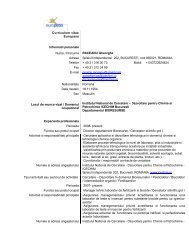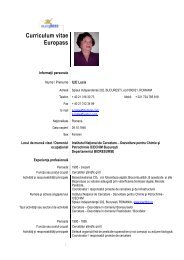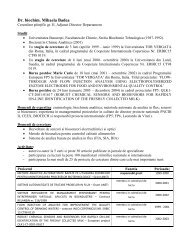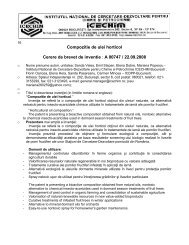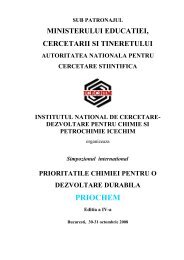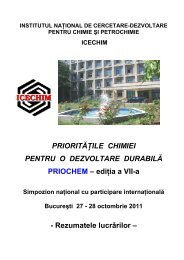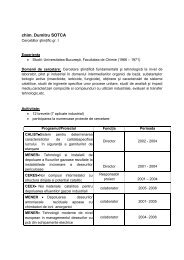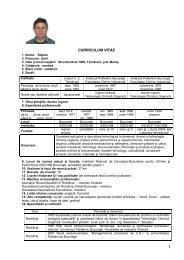INSTITUTUL NAÅ¢IONAL DE CERCETARE-DEZVOLTARE - ICECHIM
INSTITUTUL NAÅ¢IONAL DE CERCETARE-DEZVOLTARE - ICECHIM
INSTITUTUL NAÅ¢IONAL DE CERCETARE-DEZVOLTARE - ICECHIM
- No tags were found...
You also want an ePaper? Increase the reach of your titles
YUMPU automatically turns print PDFs into web optimized ePapers that Google loves.
2. Multifunctional materials and nanocomposites - PINVESTIGATION OF POLYMER NANOCOMPOSITE BASED ON HYDROFOILORGANIC POLYMER, CdS AND ISOTHIOCYANATO-CHALCONES. Robu 1 , I. Culeac 2 , M. Iovu 2 , G. Dragalina 1 , A. Popusoi 1 , M. Enachi 3 , P. Petrenko 21 Moldova State University, Mateevici Str. 60, Chisinau, MD-2009, Republic of Moldova2 Institute of Applied Physics, Academiei Str. 5, Chisinau, MD-2028, Republic of Moldova3 Technical University of Moldova, Stefan cel Mare Str. 168, Chisinau, MD2012, Republic ofMoldovaNanocomposite materials have attracted much attention for application in photonics and nonlinearoptics due to their interesting properties and for the possibility of tuning of theirphysical and chemical parameters through varying the size of nanoparticles. We present hereexperimental results on polymer-based nanocomposite material made of styrene with butylmethacrylate (SBMA) (1:1), isothiocyanato-chalcone (ITCC) and inorganic semiconductorCdS. The photoluminescent nanocomposites based on SBMA, isothiocyanato-chalcone andCdS were prepared by simple chemical method using organic solvents instead of water.Fig. 1. AFM image of the nanostructured surfaceof the thin film SBMA+10%ITCC+10%CdSdeposited on a glass substrate covered with SnO 2 .The concentration of CdS semiconductor particles was varied in the range 0-20 %. Thin filmcomposite samples have been characterized by UV-VIS absorption and photoluminescent(PL) spectroscopy, X-ray diffraction, as well as by atomic-force microscopy (AFM).Examination of the thin film surface by AFM shows that the surface of the composite can bedescribed as quasi-ordered structure with conic-shaped elements, 25-50 nm high, almostregularly distributed on the surface of the films. The X-ray diffraction pattern correlates withthe corresponding value obtained from the UV-VIS absorption spectrum, and was found tovary in the range 9-17 nm. The PL emission spectra have been registered at room temperatureunder the excitation of UV nitrogen laser beam at =337 nm. The nanocomposite samplesexhibit a strong luminescent band in the range 400-650 nm, with the photoluminescentmaximum varying slightly in dependence of the CdS concentration. It is supposed that PL isassociated to surface-state emission.




